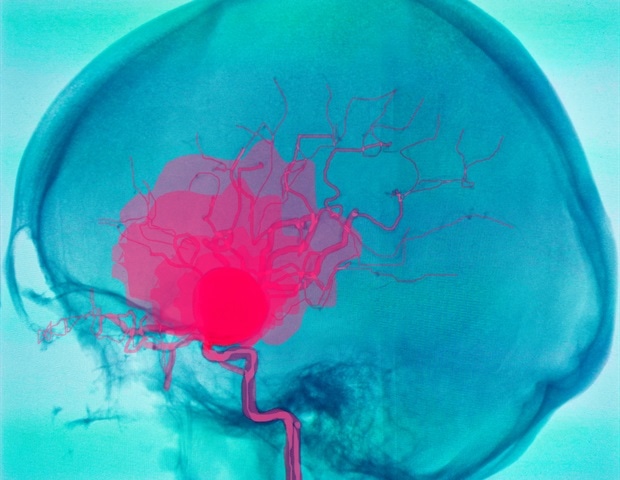Researchers conducted a database search to investigate whether aspirin can aid in the prevention of intracranial aneurysm rupture by hindering aneurysm growth. The researchers identified 146 patients harboring multiple intracranial aneurysms, five millimeters or less in diameter, that had been observed for at least five years. In this set of patients, the researchers found an association between aspirin use and a decreased rate of aneurysm growth. Growth is important in intracranial aneurysms because it increases the risk of aneurysm rupture. Detailed findings are found in the article, “Aspirin associated with decreased rate of intracranial aneurysm growth,” by Mario Zanaty, M.D., and colleagues, published today in the Journal of Neurosurgery (https://thejns.org/doi/full/10.3171/2019.6.JNS191273).
Background
An intracranial aneurysm is a cerebrovascular disorder in which the wall of an artery in the brain has weakened and bulges outward. The worry is that the weakened aneurysm wall might rupture, causing subarachnoid hemorrhage-;bleeding in the brain.
According to the Brain Aneurysm Foundation, in the United States an estimated 6.5 million people have an unruptured intracranial artery. It is not unusual to have more than one. Many small aneurysms do not cause symptoms and are unlikely to rupture. We may only know that they exist because they are identified on imaging studies obtained for another reason.
Each year, however, approximately 30,000 people in the United States experience aneurysm rupture. A ruptured aneurysm can result in substantial disability and even death.
Aneurysms larger than 7 mm are more likely to rupture than small ones. Unfortunately, some small aneurysms grow, increasing the risks that they may rupture. It is for this reason that physicians observe small, unruptured aneurysms over time by asking patients to undergo regularly scheduled imaging examinations. When it comes to the brain, intervention carries risks as well, and most neurosurgeons would prefer not to treat a small, unruptured aneurysm unless the risk of rupture meets or exceeds the risk of intervention.
The authors of this paper note, “to date, there is no medical treatment to arrest aneurysm growth and subsequent progression to rupture.” If there were, patients could feel assured that the risk of aneurysm rupture would remain steady. The authors do tell us that there has been some evidence that aspirin may reduce the risk of aneurysm rupture due to the drug’s anti-inflammatory effect on the weakened aneurysm wall. Their aim in the current study was to discover whether aspirin can protect against aneurysm growth in a population of patients harboring multiple small intracranial aneurysms.
Present study
The data collected by the researchers came from the medical records of 146 patients with multiple intracranial saccular aneurysms, who had undergone surgical or endovascular treatment by the senior author, David M. Hasan, M.D., initially for one aneurysm that had ruptured or was deemed at risk for rupture. Following treatment of this primary aneurysm, the patients still harbored a total of 229 intracranial aneurysms, all of which measured five millimeters or less. These 229 aneurysms are the focus of this paper. The patients periodically returned for follow-up appointments with Dr. Hasan, during which their remaining aneurysms were assessed for growth. Growth was defined as an increase in aneurysm size of at least one millimeter. If growth was identified, the aneurysm was treated. This occurred with 24 aneurysms.
By the end of the study period (July 2009–January 2019), each patient had been monitored for at least 5 years. None of the 229 aneurysms ruptured during the study period.
To examine what factors might lead to aneurysm growth or protect against aneurysm growth over time, the authors performed univariate and multivariate analyses on a variety of demographic and aneurysm-related information retrieved from the database. These included patient age and sex, family and patient medical history, present comorbidities, aneurysm size and location in the brain, status of the primary aneurysm (ruptured or unruptured) prior to treatment, type of procedure used to treat aneurysms, daily use of at least 81 milligrams aspirin, and use of another anticoagulant medication.
According to the univariate analysis, significant predictors of aneurysm growth included a patient’s history of ruptured aneurysm, drug abuse, hypertension, and polycystic kidney disease. There was an association between both aspirin use and one type of treatment, stent-assisted coil embolization, and a lower rate of aneurysm growth. In the multivariate analysis, the independent factors associated with aneurysm growth were again patient’s history of ruptured aneurysm, drug abuse, hypertension, and polycystic kidney disease. Only aspirin use proved to be associated with a significant decreased rate of aneurysm growth.
On the basis of the statistical analyses, use of aspirin appears to exert a protective effect against aneurysm growth and very likely against future rupture.
The authors point out that their findings are observational and that future, interventional studies should be conducted.
When asked about the study, Dr. Hasan said,
This study is very promising, as it outlines for the first time the potential therapeutic effect of aspirin in decreasing aneurysm growth. If proven in a larger study, this could offer the first, cheap, effective over-the-counter therapeutic agent that could halt aneurysm growth and prevent rupture. Many people around the world could benefit from this.”
Zanaty, M., et al. (2019) Aspirin associated with decreased rate of intracranial aneurysm growth. Journal of Neurosurgery. doi.org/10.3171/2019.6.JNS191273.
